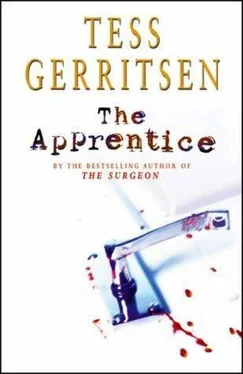“What does that mean? Eclosed?” asked Rizzoli.
“It means they’re empty. The flies have hatched.”
Dean asked, “What’s the developmental time for Calliphoridae in this region?”
“At this time of year, it’s about thirty-five days. But notice how these two puparia differ in color and weathering? They’re all from the same species, but this casing’s had longer exposure to the elements.”
“Two different generations,” said Isles.
“That would be my guess. I’ll be interested to hear what the entomologist has to say.”
“If each generation takes thirty-five days to mature,” said Rizzoli, “does that mean we’re talking seventy days of exposure? Is that how long this victim has been lying there?”
Dr. Pepe glanced at the bones on the table. “What I see here is not inconsistent with a postmortem interval of two summer months.”
“You can’t get more specific than that?”
“Not with skeletonized remains. This individual may have been lying in those woods for two months. Or six months.”
Rizzoli saw Korsak roll his eyes, so far unimpressed by their bone expert.
But Dr. Pepe was just getting started. He shifted his focus to the remains on the table. “A single individual, female,” he said, surveying the array of bones. “On the small side-not much taller than five-foot-one. Healed fractures are obvious. We have an old comminuted femoral fracture, treated with a surgical screw.”
“Looks like a Steinman pin,” said Isles. She pointed to the lumbar spine. “And she’s had a surgical fusion of L-2 and L- 3.”
“Multiple injuries?” asked Rizzoli.
“This victim has had a major traumatic event.”
Dr. Pepe continued his inventory. “Two left ribs are missing, as well as…” He shuffled through the collection of tiny hand bones. “… three carpals and most of the phalanges from the left hand. Some scavenger made off with a snack, I’d say.”
“A hand sandwich,” said Korsak. No one laughed.
“Long bones are all present. So are all the vertebrae…” He paused, frowning at the neck bones. “The hyoid’s missing.”
“We couldn’t find it,” said Isles.
“You sifted?”
“Yes. I went back to the site myself to look for it.”
“It may have been scavenged,” said Dr. Pepe. He picked up a scapula-one of the wing bones that flare out behind the shoulder. “See the V-shaped punctures here? They were made by canine and carnissial teeth.” He looked up. “Was the head found separated from the body?”
Rizzoli answered, “It was lying a few feet from the torso.”
Pepe nodded. “Typical of dogs. For them, a head is like a big ball. A plaything. They’ll roll it around, but they can’t really sink their teeth into a head, the way they can a limb or a throat.”
“Wait,” said Korsak. “Are we talking Fifi and Rover here?”
“All canids, wild and domestic, behave in similar ways. Even coyotes and wolves like to play with balls, just like Fifi and Rover. Since these remains were in a suburban park, surrounded by residences, domestic dogs would almost certainly have frequented those woods. Like all canids, their instinct is to scavenge. They’ll gnaw on any areas they can get their jaws around. The margins of the sacrum, the spinous processes. The ribs and iliac crests. And of course, they’ll tear away any soft tissue that still remains.”
Korsak looked appalled. “My wife has a little Highland terrier. That’s the last friggin‘ time I let him lick me on the face.”
Pepe reached for the cranium and shot Isles a mischievous look. “So let’s play pimp time, Dr. Isles. What’s your call on this?”
“ Pimp time ?‘ asked Korsak.
“It’s a term from medical school,” said Isles. “ Pimping someone means to test their knowledge. To put them on the spot.”
“Something I’m sure you used to do to your pathology students at U.C.,” said Pepe.
“Ruthlessly,” Isles admitted. “They’d cringe whenever I looked their way. They knew a tough question was coming.”
“Now I get to pimp you,” he said, with a touch of glee. “Tell us about this individual.”
She focused on the remains. “The incisors, palate shape, and skull length are consistent with the Caucasoid race. The skull is on the small side, with minimal supraorbital ridges. Then there’s the pelvis. The shape of the inlet, the suprapubic angle. It’s a Caucasian female.”
“And the age?”
“There’s incomplete epiphyseal fusion of the iliac crest. No arthritic changes on the spine. A young adult.”
“I concur.” Dr. Pepe picked up the mandible. “Three gold crowns,” he noted. “And there’s been extensive amalgam restoration. Have you done X rays?”
“Yoshima did them this morning. They’re on the light box,” said Isles.
Pepe crossed to look at them. “She’s had two root canals.” He pointed to the film of the mandible. “Looks like gutta percha canal fillings. And look at this. See how the roots of seven through ten and twenty-two through twenty-seven are short and blunt? There’s been orthodontic movement.”
“I didn’t notice that,” said Isles.
Pepe smiled. “I’m glad there’s something left to teach you, Dr. Isles. You’re beginning to make me feel quite superfluous.”
Agent Dean said, “So we’re talking about someone with the means to pay for dental work.”
“Quite expensive dental work,” added Pepe.
Rizzoli thought of Gail Yeager and her perfectly straight teeth. Long after the heart ceased to beat, long after the flesh decayed, it was the condition of the teeth that distinguished the rich from the poor. Those who struggled to pay the rent would neglect the aching molar, the unsightly overbite. The characteristics of this victim were beginning to sound hauntingly familiar.
Young female. White. Well-to-do.
Pepe set down the mandible and shifted his attention to the torso. For a moment he studied the collapsed cage of ribs and sternum. He picked up a disarticulated rib, arched it toward the breastbone, and studied the angle made by the two bones.
“Pectus excavatum,” he said.
For the first time, Isles looked dismayed. “I didn’t notice that.”
“What about the tibias?”
Immediately she moved to the foot of the table and reached for one of the long bones. She stared at it, her frown deepening. Then she picked up the matching bone from the other limb and placed them side by side.
“Bilateral genu varum,” she said, by now sounding quite disturbed. “Maybe fifteen degrees. I don’t know how I missed it.”
“You were focused on the fracture. That surgical pin’s staring you in the face. And this isn’t a condition one sees much anymore. It takes an old guy like me to recognize it.”
“That’s no excuse. I should have noticed it immediately.” Isles was silent a moment, her vexed gaze flitting from the leg bones to the chest. “This does not make sense. It’s not consistent with the dental work. It’s as if we’re dealing with two different individuals here.”
Korsak cut in, “You mind telling us what you’re talking about? What doesn’t make sense?”
“This individual has a condition known as genu varum,” said Dr. Pepe. “Commonly known as bowed legs. Her shinbones were curved about fifteen degrees from straight. That’s twice the normal degree of curvature for a tibia.”
“So why’re you getting all excited? Lotta folks have bow legs.”
“It’s not just the bow legs,” said Isles. “It’s also the chest. Look at the angle the ribs make with the sternum. She has pectus excavatum, or funnel chest. Abnormal bone and cartilage formation caused the sternum-the breastbone-to be sunken in. If it’s severe, it can cause shortness of breath, cardiac problems. In this case, it was mild, and probably gave her no symptoms. The condition would have been primarily cosmetic.”
Читать дальше












